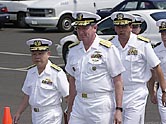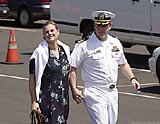 Families tearfully accept donations Families tearfully accept donations
 Admiral articulates procedural mistakes Admiral articulates procedural mistakes
 Key figures at the court of inquiry Key figures at the court of inquiry
 A Tribute to the Missing A Tribute to the Missing
 Previous stories Previous stories
By Mike Gordon
Advertiser Staff Writer
Two senior officers aboard the USS Greeneville felt the submarine’s captain was preparing a complex surfacing procedure too quickly but raised no objections before the submarine collided with a Japanese fishing vessel, according to an admiral testifying yesterday before a Navy court of inquiry.
| Court of inquiry’s schedule of events
Today
 8 a.m.: Morning session convenes with testimony resuming from Rear Adm. Charles H. Griffiths Jr. Testimony also expected from Capt. Thomas G. Kyle, USN, N7, Submarine Forces, Pacific; and Rear Adm. Albert H. Konetzni Jr., commander, Submarine Forces, Pacific. 8 a.m.: Morning session convenes with testimony resuming from Rear Adm. Charles H. Griffiths Jr. Testimony also expected from Capt. Thomas G. Kyle, USN, N7, Submarine Forces, Pacific; and Rear Adm. Albert H. Konetzni Jr., commander, Submarine Forces, Pacific.
 1 p.m.: Afternoon session convenes, testimony continues. 1 p.m.: Afternoon session convenes, testimony continues.
 4:30 p.m.: Afternoon session adjourns. 4:30 p.m.: Afternoon session adjourns.
|
The Greeneville captain on the day of the accident, Cmdr. Scott Waddle, was portrayed as a leader whose decisions were respected and seldom questioned by a largely admiring crew.
The second day of the Navy’s inquiry into the Feb. 9 collision with the Ehime Maru offered greater insight into the submarine’s mission that day as well as a revealing glimpse of the alarm that was felt by some of those aboard.
The collision killed nine of the 35 people aboard the fishing vessel, which now rests on the ocean floor nine miles south of Diamond Head.
Rear Adm. Charles H. Griffiths Jr., who investigated the accident for the Navy, told the court of the concerns felt by the submarine’s executive officer, Lt. Cmdr. Gerald K. Pfeifer, and the chief of staff of U.S. Pacific Fleet’s submarine force, Capt. Robert L. Brandhuber, who was on board to escort 16 civilian guests.
Waddle, Pfeifer and Lt. j.g. Michael Coen, who was the officer of the deck at the time of the accident, are all parties to the inquiry and could face exoneration or criminal penalties, including court-martial. Although Brandhuber was not named as a party, the court has been ordered to investigate whether he was in a position to prevent the deadly collision.
Sonar check too brief
As the Greeneville was brought up to 150 feet below the surface so it could raise its periscope, the crew’s sonar check for surface obstacles was too brief, said Griffiths, who gave details of the accident for 3 1/2 hours yesterday afternoon. The process, which typically takes 10 to 15 minutes, was accomplished in less than half that time by Waddle.
 |
| Japanese Rear Adm. Isamu Ozawa, left, and members of the court of inquiry arrive for the hearing. Ozawa’s role on the panel is advisory.
Richard Ambo • The Honolulu Advertiser |
And once the captain had the periscope above the waves, his 80-second check of the surface was clearly less than the three minutes submariners usually take when they are not worried about enemy contacts, Griffiths said. Additionally, the "high look" — the periscope’s uppermost viewing position — was too low, he said.
"The executive officer felt the amount of time was abbreviated," Griffiths testified. "And if nothing else, the ship’s depth ordered for high look was not shallow enough. He was thinking these things mentally, but not articulating them to the commanding officer or the officer of the deck."
Brandhuber, who was at the rear of the cramped control room, had the expertise to know what was safe, something Griffiths said he has thought about a lot since interviewing the chief of staff.
"I honestly thought he probably should have had some signals going off in his mind that some things weren’t being heard. I know he is, in hindsight, going over this again and again because he brooded about this in his interviews. I think he should have had a sense that corners were being cut."
Within ‘threshold’
Griffiths said he sensed from his interview with Brandhuber that the exercise was being performed too hastily. "The implication was, too quick for the evolution of this exercise," he said.
Griffiths said it would be normal for a senior officer such as Brandhuber to observe rather than usurp the skipper’s authority.
"He specifically told me he did not see anything that met his threshold to advise the commanding officer," Griffiths testified. "He had a sense that things were going quickly, but he did not see anything that violated thresholds he had internally set to advise of any changes."
 |
| Navy Cmdr. Scott Waddle and his wife, Jill, arrive for the afternoon session of the court of inquiry held at Pearl Harbor.
Richard Ambo • The Honolulu Advertiser |
The Greeneville’s trip that day had only one purpose, Griffiths said: "To demonstrate the prowess of the warship for the visitors." No training whatsoever was scheduled, a practice that the Navy frowns on during such trips.
Although the group of visitors was considered average in size, the guests prevented clear visibility among the working crew inside the control room during the surfacing procedure, a "main emergency ballast blow." But Griffiths said as many as five additional submariners could operate effectively in the same space during battle conditions.
In his interviews with the Greeneville crew members, Griffiths said he discovered they were "experienced and used to success." The submariners also worked for a commander who gave orders with authority.
"One of the potential implications of a ship that operates this way is the commanding officer doesn’t get a lot of corrective input from subordinates because he is very involved in giving directives and the ship is usually successful when he does," Griffiths said.
Courtroom scene
During the testimony, all three Greeneville officers and their attorneys bent their heads, furiously taking notes while members of their families sat silently behind them in the courtroom. Waddle’s wife, Jill, sat in the first row fidgeting with her sweater.
On the other side of the aisle sat the families of the victims from the Ehime Maru, listening to translations of the proceedings on headsets. Family members have said they are upset that Waddle has not directly acknowledged them in the courtroom, and they feel his chewing gum throughout the testimony is disrespectful.
Yesterday morning, the members of the court toured the Greeneville with the parties involved and their attorneys to familiarize themselves with the ship’s control room, its navigational equipment and its tight spaces.
The ship is in dry dock at Pearl Harbor Naval Shipyard.
Although Waddle was told by the court that he did not have to return to his former command, the sub’s former captain joined the orientation along with the other parties.
Later, they went to a submarine simulator to experience what the Greeneville crew felt during the emergency blow.
Griffiths remains on the stand today, when he may be cross-examined by the parties’ attorneys.
Advertiser Washington Bureau reporter Susan Roth contributed to this report.
[back to top] |


